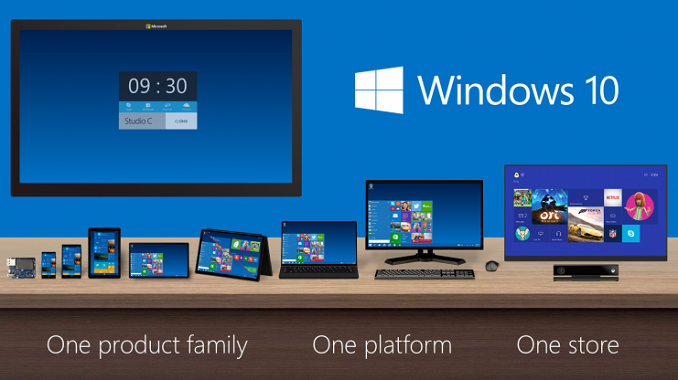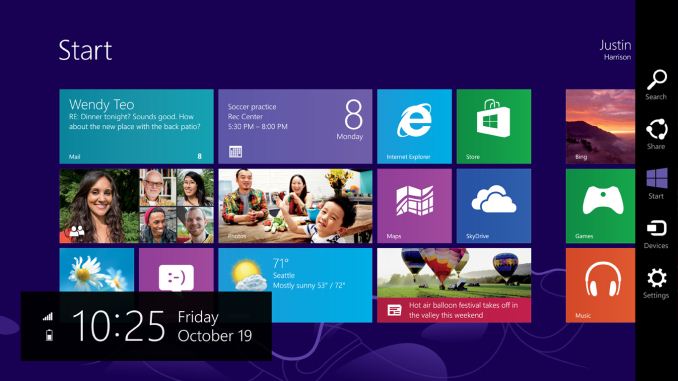Windows 10 Technical Preview First Impressions: The Return Of The Desktop
by Brett Howse on November 13, 2014 8:00 AM EST- Posted in
- Software
- Microsoft
- Windows 10

I’ve said this before, and I will reiterate it now. Windows 8, in general, is not perceived in a positive light. Not necessarily because of the lack of features, or even due to the touch first interface, but because from the start people did not buy into the paradigm. We can argue over why that was, and the specifics are likely different for every individual. But a big part of that was that Windows, which has had a familiar interface since Windows 95, had changed dramatically in look, feel, and general use. The traditional mouse and keyboard PC and notebook is a big part of the Windows user base, and especially at the beginning, Windows 8 did not cater to that crowd. While there were certainly improvements to the desktop, it was not enough to overcome the negative feelings of many users in regards to being productive on their PC. I say this as a fan of Windows 8.1, and I say this despite the positive review from this site. Windows 8 was an OS that worked, but had a steep learning curve that many people did not want to bother learning.
One of the biggest issues facing Windows 8 was just how much people liked Windows 7. Windows 7 was seen as the savior to Vista, and fixed many of its issues. But a lot of the initial problems with Vista were due to a major change in the driver model as well as the security model, which caused a lot of compatibility issues with older programs which expected administrator rights, as well as many hardware devices needed driver updates. With Windows 7, all of those changes were in the rear view mirror, allowing 7 to be a tweak of the overall UI and functionality rather than a rebuild of the OS from the ground up. With Windows 8, the move to touch first caused another dramatic upheaval. This time, rather than incompatible programs and hardware, we got a new Start Screen, a new runtime in WinRT, and a new app model with the Windows Store. For reasons that will never be made clear, the familiar start button was even removed, with the designers relying on hidden functions such as the hot corners to navigate around the OS with a mouse and keyboard. Luckily this change was reversed for Windows 8.1, with the start button returning, even if it still opened the Start Screen. With the Windows 8.1 Update, the system was made much more usable for a mouse and keyboard with the return of the menu bar to close apps, rather than dragging them down off the screen, and several other changes as well which brought the balance back somewhat to cover both touch interfaces as well as the mouse and keyboard.
 Windows 8 at launch in October 2012
Windows 8 at launch in October 2012
With Windows 8, Microsoft tried out an operating system which would work with a single interface across a breadth of hardware, from small form factor tablets, up to 30” monitor desktops. While they certainly succeeded in creating an interface that worked across all of those platforms, it was not ideally suited to any of them. With the tablet mode, the new Start Screen worked very well, and the charms menu and app switcher were fairly easy to use. But many of the settings and programs would be on the desktop, where touch only worked sparingly. Some desktop applications, such as Office, were created with a touch mode to increase the size of the onscreen elements, but overall the experience was subpar. Similarly, on the desktop, the touch interfaces were not ideal, and the hot corners certainly had issues especially on multi-monitor systems.
Windows 10 Technical Preview at launch
But now we come to Windows 10. Windows 10 is ditching the “One Interface to Rule them All” mentality, and moving to a more user friendly model of a single store across all platforms, and multiple interfaces to the same OS depending on the current usage model. We have not seen all of this in practice as of yet in the Technical Preview, but Microsoft has demonstrated their solution to this change in input mode with a feature they are calling Continuum.
The goal is that those that are on a keyboard and mouse based system will have the traditional start menu and desktop, with apps in windows, but if you are on a touch based device, or if you go on a 2-in-1 from keyboard to touch, the system will switch to the Windows 8 style start screen with full screen apps.
One of the keys to having this experience is an app model that allows a developer to target this different user interface paradigms. Microsoft’s solution to this is Universal Apps.











198 Comments
View All Comments
Zingam - Thursday, November 13, 2014 - link
What an ugly Start menu! The old fashioned Start Menu was always a very poorly designed and retarded way to access your applications and now they've managed to do it even worse!!! I'd rather have the Windows 8.1 Start Screen.Mikemk - Thursday, November 13, 2014 - link
-12 degrees? That's coldBrett Howse - Friday, November 14, 2014 - link
Everything is relative :) I'd say anything below -20°C is uncomfortable, and -30° to -40° is cold. After -40° it's insane.JimmiG - Thursday, November 13, 2014 - link
With Start8 I could probably tolerate Windows 8.1. However the OS itself doesn't really offer anything for me over Windows 7. Sure there are a few overlooked but neat new features in Explorer and I might even gain 0.3 FPS in some game due to efficiency improvements, but that's hardly worth the cost or even the time spent for upgrading.Windows 10 would have to bring some serious improvements in addition to not blowing a 27" full-screen launcher into my face every time I want to launch Notepad or Calc.
ZenKiyoshi - Thursday, November 13, 2014 - link
How about display scaling?atlantico - Friday, November 14, 2014 - link
The return of the desktop??? The desktop was *never* gone. Idiots.loki1725 - Friday, November 14, 2014 - link
What do you use your computer for? As an engineer, nearly every piece of software I use was purchased. I paid just over $8,000 to renew the license on my Matlab software + toolboxes this morning. Between that and 3D CAD tools, you have 80% or more of my daily computer use. The rest is Office, and I'll admit I haven't used 365 much as I've always had MS Office Pro. Maybe that could be taken over. But there is still a huge need for paid 'apps' on the desktop, especially in the enterprise.croc - Friday, November 14, 2014 - link
Personally, I'd be happy with Win 10 just as it is (build 9879). Obviously there are some bumps in the road, and some things have not been thought through, but MS does seem to have listened to the sound of their customer base disappearing... (Do disappearing customers REALLY make a sound?) Win 10 is indeed built to be a desktop OS for people that have desktops, and is certainly touch capable for those that have touch interface needs. Or, that seems to be what I've read in the forums anyway, about the touchy crowd.If I were still working, I'd be crying loudly for some changes to the multiple desktop model, but plenty of people are also pointing out the issues with that model as it stands. I am sure that it will become more like the CDE versions that many Unix types have come to know and love.
Some form of aero-ing would be nice, but that is a matter of preference for some. I can live without it, it is easy enough to see which window has 'focus'.
I cannot speak to the real issues, the networking, group policy stuff etc., so I won't. But the memory model! What a joy! This OS tosses ram around like the Harlem Globetrotters on a VERY good day! As a for-instance, a game I run is Skyrim. My version is heavily modded, and in a script intensive kind of way. Load screen times are down about half just by running in Win 10 vs. Win 7. Another ram-intensive application I use a lot is 3DS Max. Re-rendering a model now takes about a third the time. I'd hate to see the performance of something like ACAD or 3DS Max written exclusively to take advantage of Win 10's memory modeling...
SirPerro - Friday, November 14, 2014 - link
There is no way Adobe and other huge software makers are going to pay Microsoft to publish the software on their store. The only chance Microsoft has is making the distribution free if they want to succeed.Otherwise it's just the same story all over again: Install windows 8.1, do not sign-up for Microsoft account, use the PC as you've always done. That's my install workflow. That will be probably my install workflow for Win 10.
asmian - Friday, November 14, 2014 - link
How easy is it to remove ALL the MS-account-related features, though? Meaning not just disable, but REMOVE.I'll never use a paid app store, or any MS email service, or the cloud in any form. I don't need weather widgets or photo editing tools that are toys compared to proper heavyweight apps I've paid for. I don't want IE or Bing search as I have better alternatives, and if I had to use calc or wordpad or other utilities I don't have free alternatives for I'd probably copy the .EXE files from Win7... So can I strip all that useless crap out and have a smaller, totally Metro app-free, non-MS-account system? That's what I need to know before I give up Win7.